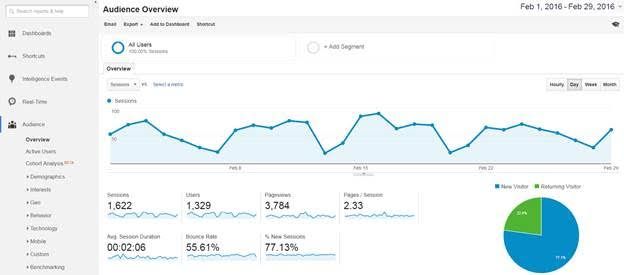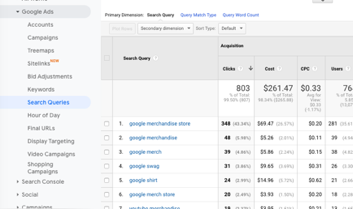A Comprehensive Guide to What Is a "Metric" in Google Analytics and Its Role in Monitoring Efficiency
A Comprehensive Guide to What Is a "Metric" in Google Analytics and Its Role in Monitoring Efficiency
Blog Article
Enhance Your Method Utilizing Effective Google Analytics Metrics
In the world of digital marketing, the use of robust Google Analytics metrics holds the essential to unlocking invaluable insights that can move your calculated endeavors to brand-new elevations. Understanding the intricate details of customer behavior, conversion rates, and website traffic sources is simply the suggestion of the iceberg when it comes to leveraging Google Analytics effectively.
Recognizing Target Market Actions
When diving into the world of Google Analytics metrics, one of the important aspects to understand is comprehending audience behavior - what is a “metric” in google analytics. Audience actions describes just how users communicate with a web site or on the internet material. By analyzing this data, services can obtain beneficial insights into their target demographics, behaviors, and choices
Google Analytics offers a riches of details on audience actions, consisting of metrics such as the variety of site visitors, their geographic location, gadgets utilized, and the web pages they go to most regularly. Understanding these metrics can aid companies tailor their advertising and marketing approaches, content, and customer experience to better satisfy their target market.
Monitoring Conversion Rates
To properly gauge the success of on-line advertising and marketing initiatives and site performance, services have to concentrate on tracking conversion prices. Conversion prices suggest the portion of site visitors who take a wanted activity, such as making a purchase, enrolling in a newsletter, or filling in a contact type. By tracking these conversions, services can evaluate the performance of their marketing campaigns, site material, and individual experience.

Additionally, companies can make use of Google Analytics to assess conversion funnels, which reveal the actions individuals take in the past finishing a conversion. By recognizing any drop-off factors in the funnel, companies can make required adjustments to enhance the user journey and increase conversion rates. Tracking conversion rates is essential for businesses wanting to optimize their on-line performance and accomplish their advertising objectives.
Analyzing Website Traffic Sources
Among the crucial elements of recognizing online performance and maximizing advertising techniques is analyzing website traffic sources. By delving into where your site site visitors are originating from, you can acquire important insights into the efficiency of your advertising initiatives and make data-driven decisions to improve your online existence. Google Analytics supplies a wide range of details on the sources of your web traffic, classifying them into channels such as natural search, direct website traffic, social media, references, and paid search.
Examining web traffic sources allows you to identify which channels are driving the most site visitors to your website, as well as which ones are leading to the highest possible conversions. By recognizing these patterns, you can allot your advertising budget plan better, focusing on networks that generate top quality traffic and readjusting strategies for underperforming ones (what is a “metric” in google analytics). Furthermore, recognizing the sources of your website traffic can aid you customize your web content and messaging to far better reverberate with your target audience across various networks, eventually causing enhanced interaction and conversion prices
Monitoring Internet Site Efficiency
Google Analytics Metrics can offer very useful insights when it pertains to special info monitoring website efficiency. By analyzing essential metrics such as web page lots time, bounce price, and conversion prices, internet site proprietors can get a detailed understanding of exactly how well their website is performing. Web page tons time is a critical metric as it directly affects individual experience and can impact bounce prices. Monitoring this metric can help recognize locations for improvement to ensure ideal website speed.
Bounce price is another important statistics to track as it suggests the percent of visitors that leave the website after checking out only one page. A high bounce rate might suggest that the site's content or individual experience needs enhancement. On the various other hand, conversion rates disclose how efficient the website is at converting visitors right into leads or clients. By keeping an eye on and assessing these metrics routinely, website proprietors can make data-driven decisions to enhance their website's performance and enhance customer experience.
Implementing Customized Reports
Just how can internet site owners obtain deeper understandings right into their analytics data past the common records provided by Google Analytics? By carrying out customized records, companies can customize their analytics to particular requirements and goals. Custom reports permit customers to concentrate on certain metrics, measurements, and sections that are most relevant to their organization goals. This level of modification allows a much more in-depth evaluation of web site efficiency, customer actions, and advertising strategies.
To produce personalized reports in Google Analytics, individuals can navigate to the "Personalization" tab and pick "Personalized News - what is a “metric” in google analytics." From there, they can select filters, dimensions, and metrics to include in their records. Custom records can vary from basic to complex, depending on the depth of understandings required. By using customized reports, website proprietors can uncover special patterns, patterns, and chances that might not be readily noticeable in typical reports.

Final Thought
To conclude, leveraging powerful Google Analytics metrics can offer useful understandings into audience behavior, conversion rates, web traffic resources, site efficiency, and custom-made records. By assessing these key metrics, businesses can maximize their approaches, improve customer experiences, and drive much better results. Continual monitoring and modifications based on data-driven decisions can result in boosted on the internet visibility and enhanced success in check these guys out achieving company goals.
Understanding the detailed information of customer habits, conversion prices, and website traffic resources is simply the tip of the iceberg when it comes to leveraging Google Analytics efficiently.To effectively gauge the success of online advertising efforts and website performance, organizations have to focus on tracking conversion prices.In addition, organizations can use Google Analytics to analyze conversion funnels, which reveal the steps individuals take previously completing a conversion. By examining essential metrics such as informative post page tons time, bounce rate, and conversion prices, website owners can get a comprehensive understanding of exactly how well their website is doing.In conclusion, leveraging effective Google Analytics metrics can offer important insights into target market habits, conversion rates, traffic resources, site performance, and custom records.
Report this page